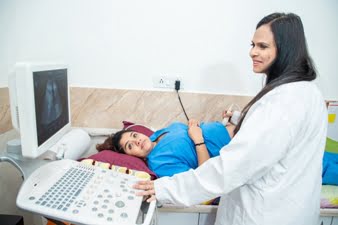Why is the USG Abdomen + RIF Scan Important?
This scan is particularly useful for assessing a wide range of abdominal and pelvic conditions, especially those affecting the lower right part of the abdomen. Here’s why this test is commonly recommended:
1. Diagnosis of Acute Appendicitis: The right iliac fossa is the typical location of the appendix. This scan helps detect signs of acute appendicitis, such as an inflamed appendix, fluid collection, or an abscess, which is one of the most common causes of severe lower abdominal pain.
2. Evaluation of Abdominal Organs: The abdominal ultrasound assesses major organs, including the liver, gallbladder, kidneys, pancreas, spleen, and urinary bladder. It helps in diagnosing conditions like gallstones, kidney stones, liver disease, and tumors, providing a comprehensive overview of abdominal health.
3. Investigation of Right-Sided Abdominal Pain: Lower right-sided abdominal pain can be due to several conditions such as intestinal issues, right-sided ovarian cysts, or inguinal hernias. This scan helps pinpoint the source of the pain and guides further management.
4. Detection of Gynecological Issues: For women, the scan can help evaluate gynecological conditions like ovarian cysts, ectopic pregnancy, or pelvic inflammatory disease (PID) that might be causing pain in the RIF region.
5. Assessment of Lymph Nodes: Enlarged lymph nodes in the right iliac fossa may indicate infection, inflammation, or malignancy. The ultrasound helps detect and measure these lymph nodes for further evaluation.
6. Detection of Hernias: The scan is also helpful in identifying inguinal or femoral hernias, which may present as lumps or pain in the RIF area.
How is the USG Abdomen + RIF Scan Performed?
1. Preparation: For the abdominal ultrasound, you may need to fast for 4-6 hours to reduce gas in the intestines, which can interfere with the image quality. Drinking water to fill the bladder may also be recommended, especially if a pelvic assessment is included.
2. Procedure: You will lie on an examination table, and a water-based gel is applied to the abdomen to help the ultrasound probe glide smoothly and enhance sound wave transmission. The transducer (ultrasound probe) is moved over the abdomen, focusing specifically on the right iliac fossa region to capture detailed images. The sonographer may apply gentle pressure to obtain clearer views, especially when assessing for appendicitis or cysts.
3. Duration: The entire scan typically takes 20-30 minutes, depending on the complexity of the case and the findings observed during the scan.
4. Post-Procedure: After the scan, the gel is wiped off, and you can resume your normal activities immediately. The results are analyzed by a radiologist and then discussed with you by your healthcare provider.
Who Should Consider a USG Abdomen + RIF Scan?
The USG Abdomen + RIF scan is recommended for:
Patients with Right-Sided Lower Abdominal Pain: Those experiencing severe pain in the lower right abdomen should consider this scan to rule out appendicitis or other conditions causing the discomfort.
Women with Gynecological Symptoms: Women with suspected ovarian cysts, ectopic pregnancies, or pelvic inflammatory disease presenting with right-sided pain can benefit from this scan for accurate diagnosis.
Individuals Suspected of Having a Hernia: If there is a bulge or pain in the groin area, especially on the right side, the scan can help identify inguinal or femoral hernias.
Patients with Gastrointestinal Symptoms: Those with symptoms like bloating, nausea, or changes in bowel habits, along with pain in the right iliac fossa, may need this scan to check for intestinal or bowel-related conditions.









